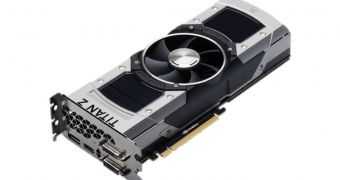A couple of days ago, when we found evidence that NVIDIA's dual-GPU graphics card was no better than AMD's own, it was clear that something was up. Now we get the closest thing amounting to a confirmation.
For those of you that were distracted by other things a couple of days ago, a comparison test between NVIDIA's GeForce GTX Titan Z and AMD's Radeon R9 295 X2 came out.
The two turned out to be pretty evenly matched, though the latter managed to beat the former in some cases, while the latter wasn't as far in the lead when it gained the upper hand.
Now, normally something like this wouldn't get out laces in a twist because it's normal for NVIDIA and AMD to be equally good at making video boards.
So, since the GeForce GTX Titan Z and Radeon R9 295 X2 are the best of the best for their respective product lines, and dual-chip products to boot, it would make sense for them to be on the same level.
Alas, NVIDIA pretty much killed all semblance of normality when it gave its GeForce GTX Titan Z a price of $3,000 / €3,000.
It essentially decreed that performance had to be at least one league above that of AMD's board, which is priced at $1,500 / €1,500.
Clearly, that is not the case, despite NVIDIA's board having 12 GB of GDDR5 VRAM instead of 8 GB.
All things considered, it was pretty obvious that NVIDIA had to make some serious optimizations to the board if it was going to sell it well.
And when the product failed to show up at the end of April, then again got delayed earlier this month, it was clear that the Santa Clara-based company was jumping through some last-minute hoops.
For one thing, the card now has a triple-slot cooler, as can be seen in the photo above. For another, NVIDIA is reportedly working on the drivers.
Technically speaking, retailers already have the GeForce GTX Titan Z, but NVIDIA told them not to sell the inventories until the drivers were ready, according to Japanese sources.
It's fortunate for the company that it managed to pull off surprising driver-based performance boosts in the past, otherwise skepticism would be running rampant on the web.
As far as we know, no hardware changes are being implemented on the video card. Well, none besides the size increase to the cooler at any rate, and that's been known for a few weeks.

 14 DAY TRIAL //
14 DAY TRIAL //